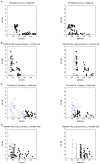Evidence for the concerted evolution between short linear protein motifs and their flanking regions
- PMID: 19584925
- PMCID: PMC2702822
- DOI: 10.1371/journal.pone.0006052
Evidence for the concerted evolution between short linear protein motifs and their flanking regions
Abstract
Background: Linear motifs are short modules of protein sequences that play a crucial role in mediating and regulating many protein-protein interactions. The function of linear motifs strongly depends on the context, e.g. functional instances mainly occur inside flexible regions that are accessible for interaction. Sometimes linear motifs appear as isolated islands of conservation in multiple sequence alignments. However, they also occur in larger blocks of sequence conservation, suggesting an active role for the neighbouring amino acids.
Results: The evolution of regions flanking 116 functional linear motif instances was studied. The conservation of the amino acid sequence and order/disorder tendency of those regions was related to presence/absence of the instance. For the majority of the analysed instances, the pairs of sequences conserving the linear motif were also observed to maintain a similar local structural tendency and/or to have higher local sequence conservation when compared to pairs of sequences where one is missing the linear motif. Furthermore, those instances have a higher chance to co-evolve with the neighbouring residues in comparison to the distant ones. Those findings are supported by examples where the regulation of the linear motif-mediated interaction has been shown to depend on the modifications (e.g. phosphorylation) at neighbouring positions or is thought to benefit from the binding versatility of disordered regions.
Conclusion: The results suggest that flanking regions are relevant for linear motif-mediated interactions, both at the structural and sequence level. More interestingly, they indicate that the prediction of linear motif instances can be enriched with contextual information by performing a sequence analysis similar to the one presented here. This can facilitate the understanding of the role of these predicted instances in determining the protein function inside the broader context of the cellular network where they arise.
Conflict of interest statement
Figures




Similar articles
-
A tree-based conservation scoring method for short linear motifs in multiple alignments of protein sequences.BMC Bioinformatics. 2008 May 6;9:229. doi: 10.1186/1471-2105-9-229. BMC Bioinformatics. 2008. PMID: 18460207 Free PMC article.
-
Attributes of short linear motifs.Mol Biosyst. 2012 Jan;8(1):268-81. doi: 10.1039/c1mb05231d. Epub 2011 Sep 12. Mol Biosyst. 2012. PMID: 21909575
-
Bioinformatics Approaches for Predicting Disordered Protein Motifs.Adv Exp Med Biol. 2015;870:291-318. doi: 10.1007/978-3-319-20164-1_9. Adv Exp Med Biol. 2015. PMID: 26387106 Review.
-
Short linear motifs - ex nihilo evolution of protein regulation.Cell Commun Signal. 2015 Nov 21;13:43. doi: 10.1186/s12964-015-0120-z. Cell Commun Signal. 2015. PMID: 26589632 Free PMC article. Review.
-
Prediction of virus-host protein-protein interactions mediated by short linear motifs.BMC Bioinformatics. 2017 Mar 9;18(1):163. doi: 10.1186/s12859-017-1570-7. BMC Bioinformatics. 2017. PMID: 28279163 Free PMC article.
Cited by
-
The sequence, structure and evolutionary features of HOTAIR in mammals.BMC Evol Biol. 2011 Apr 16;11:102. doi: 10.1186/1471-2148-11-102. BMC Evol Biol. 2011. PMID: 21496275 Free PMC article.
-
In Silico Engineering of Synthetic Binding Proteins from Random Amino Acid Sequences.iScience. 2019 Jan 25;11:375-387. doi: 10.1016/j.isci.2018.11.038. Epub 2018 Dec 4. iScience. 2019. PMID: 30660105 Free PMC article.
-
Reducing false-positive prediction of minimotifs with a genetic interaction filter.PLoS One. 2012;7(3):e32630. doi: 10.1371/journal.pone.0032630. Epub 2012 Mar 5. PLoS One. 2012. PMID: 22403687 Free PMC article.
-
A dynamic view of domain-motif interactions.PLoS Comput Biol. 2012 Jan;8(1):e1002341. doi: 10.1371/journal.pcbi.1002341. Epub 2012 Jan 12. PLoS Comput Biol. 2012. PMID: 22253583 Free PMC article.
-
MFSPSSMpred: identifying short disorder-to-order binding regions in disordered proteins based on contextual local evolutionary conservation.BMC Bioinformatics. 2013 Oct 4;14:300. doi: 10.1186/1471-2105-14-300. BMC Bioinformatics. 2013. PMID: 24093637 Free PMC article.
References
-
- Diella F, Haslam N, Chica C, Budd A, Michael S, et al. Understanding eukaryoticlinear motifs and their role in cell signaling and regulation. Front Biosci. 2008;13:6580–603. - PubMed
-
- Sigrist C, Cerutti L, Hulo N, Gattiker A, Falquet L, et al. PROSITE: a documented database using patterns and profiles as motif descriptors. Brief Bioinform. 2002;3(3):265–74. - PubMed
-
- Neduva V, Russell R. Linear motifs: evolutionary interaction switches. FEBS Lett. 2005;579(15):3342–3345. - PubMed
-
- Fuxreiter M, Tompa P, Simon I. Local structural disorder imparts plasticity on linear motifs. Bioinformatics. 2007;23(8):950–6. - PubMed
Publication types
MeSH terms
Substances
LinkOut - more resources
Full Text Sources

